There are stories I can appreciate and enjoy, and to which I can emotionally connect. Then there are the stories that I can feel right down to my bones, as if they extracted a part of me and converted that piece to an artistic medium. The Wind Rises was one, Encanto is another, and now the graphic novel Himawari House by Harmony Becker joins that list.
Himawari House is the story of three Asian girls who come to live together in Japan as exchange students. Nao is Japanese and White, originally from Japan but having grown up in the US. Meanwhile, Hyejung is South Korean and Tina is Singaporean. Though their circumstances are different and they come from different countries, they form a friendship amidst struggles with notions of identity and belonging.
In reading this, I’m reminded of my experience with the Crazy Rich Asians trilogy. I naturally couldn’t relate to the ultra wealthy or the old-money families, but could see many elements of the Asian culture I grew up both in and around, transcending class and manifesting in that story in specific ways. With Himawari House, however, I found myself relating to all three characters throughout because I would see in them pieces of my own personal struggles as a part of the Asian diaspora.
I was born and raised in the US, so I understand a young Nao’s desire to integrate into American society surrounding her at the expense of her roots. I studied abroad in Japan at around the same age as them, so I also know what it’s like to experience Japan as a foreigner with some Japanese skills who nevertheless can pass looks-wise before it becomes clear that I’m not from there. I have limited connections with the lands of my parents and those who came before them—I’ve visited literally only twice in my entire life, once when I was very young and once when I was well into adulthood. Like Nao, those trips are still a part of me. Lingering memories of the former combine with resolve from the latter to hold onto some of it, while knowing the language in an imperfect manner leads to feeling caught between worlds.
Himawari House’s portrayals of the Hyejung and Tina’s relationships with their parents also hit home. It’s all there: the looks of concern and disappointment from Hye’s parents and Tina’s description of her mom as some whirlwind of concern, love, guilt, and motherly affection. Much like Encanto, it’s like getting walloped over and over, except instead of punches to the gut it feels akin to elbows to the ribs. Which is to say, different but just as painful in its own right.
The comic does wonderful things with language in order to depict the experience of being ostensibly multilingual while also being exposed to new languages and getting reminded that maybe you don’t know your parents’ tongue as well as you maybe should. The dialogue is written with the caveat that this book is primarily for an English-literate market, but often Japanese and Korean are added as well to express what is being spoken in the original language—and to show the moments when the characters’ language comprehension fails. All the characters are also given noticeable accents in their speech, which add to the sense that they all come from different places. In English, Hyejung struggles with “f” sounds due to the lack of it in Korean while Tina speaks Singlish—a patois of English, Cantonese, Hokkien, and more—that she purposely dials back when talking to non-Singaporeans.
There’s a note in the back of the book by Becker discussing her decision to incorporate accents into the book despite their historical use as racist mockery. In essence, she’s aiming to reclaim accents as a point of pride—a natural product of learning new languages—and I can really get behind that idea. It’s a tough tightrope to walk, but I think Himawari House pulls it off with aplomb.
Based on conversations I’ve had, this book is more than capable of finding readers beyond Asian peoples and communities. That being said, I feel that it speaks to Asians on a whole other level, and that’s okay. The joys and travails of Nao, Hyejung, and Tina are universal on some levels yet deeply personalized on others, and I find myself reflecting on my own sense of self within the cultures that are a part of me.


Pingback: The Epic Highs and Lows of High School Golf: April ’22 Roundup | The Afictionado
Pingback: Dang, Spring Anime Is Really Good: Ogiue Maniax Status Update for May 2022 | OGIUE MANIAX
Pingback: The Moving Goalposts of Integration: Messy Roots | OGIUE MANIAX
Pingback: Mother of Mercilessness: Everything Everywhere All at Once | OGIUE MANIAX